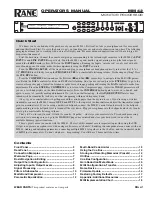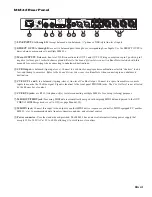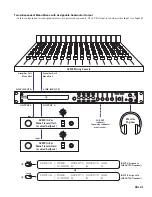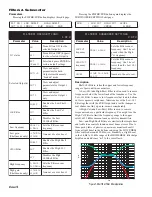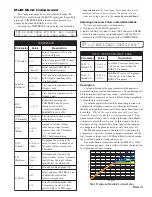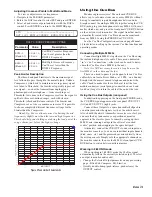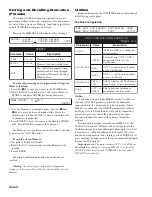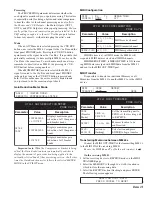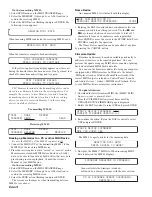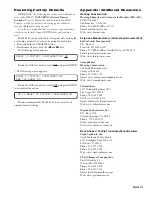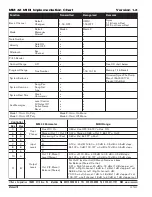
Manual-11
-20
+20
-18
-16
-14
-12
-10
-8
-6
-4
-2
0
+2
+4
+6
+8
+10
+12
+14
+16
+18
-20
+20
-15
-10
-5
0
+5
+10
+15
d
B
O
U
T
P
U
T
dB INPUT
Multi-Band Compressor
The Compressor may be used in either full-range (M-
BAND off) or multi-band (M-BAND on) modes. Repeatedly
press the COMPRESS button to move through each fre-
quency band when M-BAND is set to ON.
Pressing the COMPRESS button displays the following:
CMP ON |BND THRSH RTO ATCK REL M-BAND
OUT 1+2| 1 0dB 2.0 10ms 100ms ON
*
Important note:
the front panel Gain Reduction meter
automatically switches to display the amount of gain
reduction being applied to the
currently selected band
.
Adjusting Crossover Points in Multi-Band Mode
To view or adjust crossover frequencies:
1. Navigate to the M-BAND parameter.
2. Rotate the DATA control to select SET and press ENTER.
3. Select a band crossover point and adjust with the DATA
control. Press ENTER to return to the COMPRESSOR.
CMP
|--------X---------X----------|
OUT 1+2| BND1-2=200Hz BND2-3=2.0kHz
R
O
S
S
E
R
P
M
O
C
r
e
t
e
m
a
r
a
P
e
u
l
a
V
n
o
i
t
p
i
r
c
s
e
D
P
M
C
s
u
t
a
t
s
N
O
e
h
t
r
o
f
N
O
r
o
s
s
e
r
p
m
o
C
s
n
r
u
T
.
)
s
(
t
u
p
t
u
O
d
e
t
c
e
l
e
s
f
f
o
)
s
s
a
p
y
b
(
F
F
O
r
o
s
s
e
r
p
m
o
C
s
n
r
u
T
.
)
s
(
t
u
p
t
u
O
d
e
t
c
e
l
e
s
e
h
t
r
o
f
T
S
R
)
t
e
s
e
R
(
o
t
R
E
T
N
E
s
s
e
r
p
d
n
a
t
c
e
l
e
S
.
s
g
n
i
t
t
e
s
t
l
u
a
f
e
d
e
r
o
t
s
e
r
d
e
t
c
e
l
e
S
)
s
(
t
u
p
t
u
O
2
+
1
T
U
O
r
o
f
s
r
e
t
e
m
a
r
a
p
t
s
u
j
d
a
d
n
a
w
e
i
V
.
y
l
s
u
o
e
n
a
t
l
u
m
i
s
s
t
u
p
t
u
O
h
t
o
b
.
e
d
o
m
”
d
e
k
n
i
L
“
1
T
U
O
r
o
f
s
r
e
t
e
m
a
r
a
p
t
s
u
j
d
a
d
n
a
w
e
i
V
.
y
l
n
o
1
t
u
p
t
u
O
2
T
U
O
r
o
f
s
r
e
t
e
m
a
r
a
p
t
s
u
j
d
a
d
n
a
w
e
i
V
.
y
l
n
o
2
t
u
p
t
u
O
D
N
B
)
d
n
a
B
(
3
,
2
,
1
e
h
t
g
n
i
s
s
e
r
p
y
l
d
e
t
a
e
p
e
R
s
e
l
c
y
c
n
o
t
t
u
b
S
S
E
R
P
M
O
C
3
e
h
t
f
o
h
c
a
e
h
g
u
o
r
h
t
n
e
h
w
s
d
n
a
b
r
o
s
s
e
r
p
m
o
C
.
N
O
o
t
t
e
s
s
i
D
N
A
B
-
M
H
S
R
H
T
)
d
l
o
h
s
e
r
h
T
(
o
t
B
d
0
6
-
B
d
0
h
c
i
h
w
e
v
o
b
a
l
e
v
e
l
l
a
n
g
i
s
e
h
T
.
s
r
u
c
c
o
n
o
i
s
s
e
r
p
m
o
c
O
T
R
)
o
i
t
a
R
(
o
t
0
.
1
F
N
I
e
m
u
l
o
v
t
u
p
t
u
o
f
o
t
n
u
o
m
A
e
m
u
l
o
v
t
u
p
n
i
r
e
p
n
o
i
t
c
u
d
e
r
.
d
l
o
h
s
e
r
h
T
e
h
t
e
v
o
b
a
e
s
a
e
r
c
n
i
,
n
o
i
t
c
u
d
e
r
o
n
=
0
.
1
.
n
o
i
s
s
e
r
p
m
o
c
d
r
a
h
=
F
N
I
K
C
T
A
)
k
c
a
t
t
A
(
o
t
s
m
5
.
0
s
m
0
0
1
e
h
t
y
l
k
c
i
u
q
w
o
h
s
e
n
i
m
r
e
t
e
D
e
c
n
o
d
e
c
u
d
e
r
s
i
e
m
u
l
o
v
t
u
p
t
u
o
e
h
t
s
d
e
e
c
x
e
e
m
u
l
o
v
t
u
p
n
i
e
h
t
.
d
l
o
h
s
e
r
h
T
L
E
R
)
e
s
a
e
l
e
R
(
o
t
s
m
1
c
e
s
5
e
h
t
y
l
k
c
i
u
q
w
o
h
s
e
n
i
m
r
e
t
e
D
l
a
m
r
o
n
o
t
s
n
r
u
t
e
r
e
m
u
l
o
v
t
u
p
t
u
o
e
m
u
l
o
v
t
u
p
n
i
e
h
t
e
c
n
o
)
y
t
i
n
u
(
.
d
l
o
h
s
e
r
h
T
e
h
t
w
o
l
e
b
s
p
o
r
d
D
N
A
B
-
M
N
O
.
N
O
e
d
o
m
d
n
a
B
-
i
t
l
u
M
s
n
r
u
T
T
E
S
w
e
i
v
o
t
R
E
T
N
E
s
s
e
r
p
d
n
a
t
c
e
l
e
S
d
n
a
b
-
i
t
l
u
m
e
h
t
t
s
u
j
d
a
r
o
.
s
e
i
c
n
e
u
q
e
r
f
r
e
v
o
s
s
o
r
c
f
f
o
.
F
F
O
e
d
o
m
d
n
a
B
-
i
t
l
u
M
s
n
r
u
T
e
h
t
r
e
v
o
s
k
r
o
w
r
o
s
s
e
r
p
m
o
C
.
e
g
n
a
r
z
H
k
0
2
o
t
z
H
0
2
e
r
i
t
n
e
E
G
A
P
Y
C
N
E
U
Q
E
R
F
D
N
A
B
-
I
T
L
U
M
r
e
t
e
m
a
r
a
P
e
u
l
a
V
n
o
i
t
p
i
r
c
s
e
D
2
-
1
D
N
B
)
2
-
1
d
n
a
B
(
o
t
z
H
0
2
z
H
k
0
2
.
y
c
n
e
u
q
e
r
F
r
e
v
o
s
s
o
r
C
d
i
M
/
w
o
L
e
h
t
n
a
h
t
r
e
t
a
e
r
g
t
e
s
e
b
t
’
n
a
C
.
y
c
n
e
u
q
e
r
F
3
-
2
D
N
B
3
-
2
D
N
B
)
3
-
2
d
n
a
B
(
o
t
z
H
0
2
z
H
k
0
2
.
y
c
n
e
u
q
e
r
F
r
e
v
o
s
s
o
r
C
h
g
i
H
/
d
i
M
e
h
t
n
a
h
t
r
e
w
o
l
t
e
s
e
b
t
’
n
a
C
.
y
c
n
e
u
q
e
r
F
2
-
1
D
N
B
Description
Custom tailoring of the program material dynamics is
possible using the multi-band compressor. The audio signal is
divided into distinct frequency ranges, which are then
individually compressed as desired before being recombined
to form the processed signal.
A common application for multi-band compression is to
compress low frequencies more (or otherwise differently)
than the mid and high frequencies. How many times have you
heard this:
“Why do the vocals disappear with every bass
drum hit? It gives my mix this weird pumping sound.”
This
phenomenon is likely due to using a full-range (broadband)
compressor across the entire mix. In this scenario the low
frequency energy from the bass drum triggers the compres-
sor, dragging
all
frequencies down evenly with every hit.
Multi-band compressor to the rescue! Try adjusting the
compressor’s crossover frequency point to compress just the
low frequency range (say, 200 Hz and below) while keeping
the vocals and guitars strong and present.
The multi-band compressor used in the MM 42 is of the
rms (root mean square) variety with a soft-knee characteristic
for a pleasant, musical response.
Figure 2 Compressor Characteristic (various Ratios)

